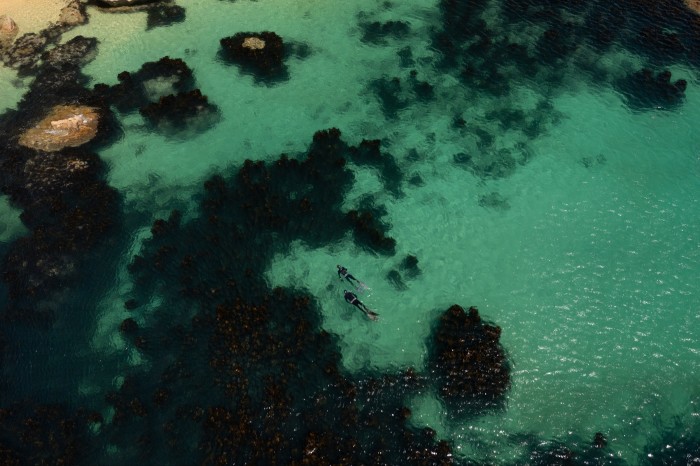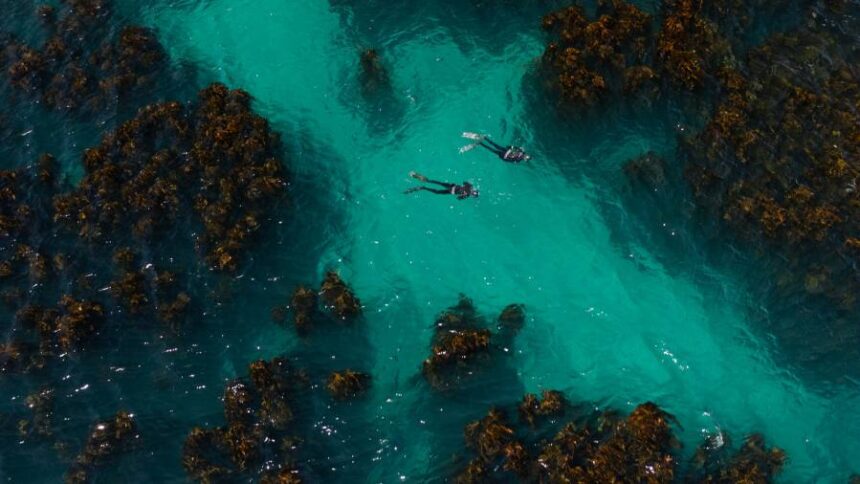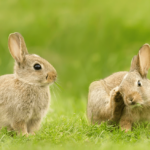We’re on a break between dives, sitting on the smooth granite boulder beach of Cosy Bay. With my back to the midday summer sun, I soak up views of Table Mountain a few miles to the north; the jagged peaks of its National Park run along the Atlantic seaboard to my right. A small seal colony on a rocky outcrop completes the panorama.
But soon enough, what’s below the water beckons again: the only giant bamboo kelp forest on the planet. “Are you ready?” asks Justin Blake, my companion and guide for the day. As well as knowing Cape Town’s coastline intimately, the South African marine biologist is a highly respected shark scientist, having dedicated most of his life’s work to studying them.


Snorkel, mask and fins in place, we slip into the cool turquoise Atlantic, and the Great African Seaforest – stretching some 1,000km from the Cape north into Namibia – once again envelops me. Around a quarter of the world’s marine coastlines are covered by these important ecosystems. They not only teem with marine life, but soak up more carbon per acre than a terrestrial forest, making them hugely important “capture” sinks.
These inshore waters are part of the Table Mountain National Park Marine Protected Area. Despite their obvious benefits to the state of life above the surface, just 2.9 per cent of the world’s oceans are fully or significantly protected from fishing impacts. It’s a number Blake is committed to growing: a shark-tagging research project he co-founded in Mozambique has contributed to doubling the size of one such marine reserve.
In 2018 Blake founded the RockHopper Fund, with all monies raised going towards scientific exploration that supports ocean conservation and marine reserve creation. So far, it’s working: a one-hour shark talk by Blake, one of the Fund’s more popular paid offerings, has more than 1,200 five-star reviews.


RockHopper also offers in-person experiences and adventures. Blake has just launched the newest – A Day in the Life of a Marine Biologist – in partnership with the Mount Nelson, a Belmond hotel. Tucked up against the foot of Table Mountain, the Mount Nelson is a city icon, with past residents including Winston Churchill and Nelson Mandela; as local partners go, it doesn’t get much better. Although still in its infancy, Blake tells me the experience has seen a strong uptake with hotel guests, whether families with curious children or just those looking for some sea-bound exploration. Each tour is hosted by Blake, tailored to match the guests’ sense of adventure, and most get to explore the coastline by RIB (rigid inflatable boat), adding an element of exhilaration to the educational experience.
Mine’s a one-on-one trip, just Blake and I, and I’m dead keen on finding sharks. The kelp forests here are home to nine harmless, mostly smaller, species – though the seven-gill cow shark can reach lengths of up to three metres. Blake tells me he’ll do his best, but with a large swell and strong winds the conditions mean we’re neither able to venture out on the RIB, nor dive in False Bay. So a shark sighting, particularly of a larger species, might be a long shot.
Two decades ago, great white sharks were common off Cape Town’s coastline, but they have become a rare phenomenon on this stretch in recent years. Overfished seas mean far less prey for them; the city’s close to five-million-strong population increasingly pollutes the sea. And water temperature makes a difference too: “Great whites – most shark species – can’t control their body temperature, so they now prefer the relatively warmer waters of the Indian Ocean, a few hundred kilometres up the coast to the east of The Cape,” Blake explains. Lastly, a rash of orca attacks on great whites in local waters since around 2017 has scared most of the rest of them off, it seems.
But an encounter is never entirely out of the question – a bracing thought as we gently fin further away from the shoreline to explore some denser kelp. We’re in water probably 15m deep. I’ve never tested myself in this way – free-diving and snorkelling in potentially sharky waters – and I’m surprised at how relaxed I feel. Peering down from the surface, I see a huge school of fish; hundreds and hundreds of hottentot, a species of sea bream. After a few deep breaths, I dive down, equalising as I go, trying to preserve oxygen and prolong my dive whilst maintaining forward momentum. Over the course of the morning, I have noticed an improvement: initially my maximum depth was five metres, but an hour later I’m managing nearer to 10m, with a duration of around a minute.


As I ascend, a stunning overhang unexpectedly reveals itself between huge trunks of kelp. Every square inch is occupied by a tapestry of different life forms – anemones, sea urchins, starfish, soft corals and sponge. I float immobile for several seconds, mesmerised by the kaleidoscopic view. It’s becoming clear that the real revelation of this experience is the sheer abundance of less-celebrated wildlife in the magnificent underwater forest.
I spot Blake gesturing out of the corner of my eye, and follow him on his dive down. There, tucked among thick kelp fronds, lies a dark shyshark. It’s small – less than a metre long – but it’s the first time I’ve seen a shark in the wild, and with its dark brown, rough skin, arrowhead-shaped in pattern, it’s a captivating sight. It doesn’t seem too worried by me, so I draw in for a closer look.
Blake and I surface for air before diving down again for another glimpse; but our friend has had enough of company and darts off after a few seconds. So after two hours in the water, we return to Blake’s 4×4, peel off our wetsuits, and head on the short distance to Cape Point Nature Reserve. With more than 1,100 different plant species, it’s one of the world’s most diverse floral kingdoms. In spring, Blake tells me, it’s awash with colour; and ostrich, troops of baboons, porcupines and zebra all reside here.


We park and head to a large rock pool known as Venus Pool – a great place to come if the weather isn’t playing ball. A few hundred metres out to sea in False Bay, there’s a sudden flurry – dozens of seabirds dive-bombing and dolphins leaping: the wild commotion of a bait ball. On the RIB as part of the marine biologist tour, Blake says, guests can experience the animals up close by being in the right place at the right time.
FT Weekend Festival

FT Weekend Festival returns on Saturday September 2 at Kenwood House Gardens, London. Book your tickets to enjoy a day of debates, tastings, Q&As and more . . . Speakers include Don McCullin, Feargal Sharkey, José Avillez and many others, plus all your favourite FT writers and editors. Register now at ft.com/festival.
It sounds like a thrill for sure; but Blake himself is the day’s big win whatever the activity. Whatever you’re looking to get – a swim with dolphins; a crash course in Cape marine life; or tracking tagged sharks with acoustic technology (another optional Day in the Life activity) – his expertise, combined with his easy manner and sense of humour, more or less guarantees a good day out.

Back at the Mount Nelson, over a sundowner and some biltong on the stylish terrace, I mull over the experience. I arrived seeking exhilaration – a swim with sharks – which, I suppose, I had. But what has stuck with me is the importance of conservation, and how it touches every aspect of what I saw and did. Thanks to committed people like Blake – the ones carrying out the research and raising the funds – there’s still a fighting chance for the health of our oceans.
Fergus Scholes travelled as a guest of the Mount Nelson, a Belmond Hotel, rooms from R14,000 (about £550); RockHopper Marine Biologist for a Day experience, about £990 for up to 8 people








